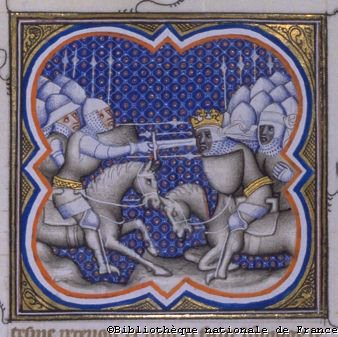
Franks and Saracens at the Battle of Roncesvalles[Source: Biblioteque Nacionale de France]
Saracens
The word Saracen is generally agreed to be of Afro-Asiatic origin, and it is far from certian that it means "Easterner". Accordingly, the term Saracen was generally believed to be originally nomadic tribes of the Arabian and Syrian deserts. They were also considered as the peoples who attacked the boarders of the Roman Empire.
Pliny the Elder, or Pliny the Naturalist (23-79 AD) appears to have been the earliest author to mention the Saracens as a group of people. St. Jerome (ca.375), in his Commentario-rum in Esaiam, identified a people in Western Asia know as Agareni (Hagerens, descendants of Hagar the Egyptian) “who are now called Saracens, taking themselves the name Sara.”
German Theologian, Rabanus Maurus (776-856) made similar findings. According to his Commentaria in Genesim, Maurus connected the Moors Typologically with the House of Ishmael. Accordingly an early Medieval Kingdom located in Mesopotamian delta was called Karacen. To the Byzantine Greco-Romans as Saracenos. According to French historian Jean-Paul Cleber, “Kara (which means black) linguistically evolved into Sarakenos, Saracin.
Another French art historian, Jean Devisse says, The Medieval Spanish painter associated the color black with the Saracens. However, Dorothee Mitlitzki stresses that “The people who contributed to the formation of what, in the Middle Ages, was known as Saracen culture, were of the most [varied] ethnic origins.
Correspondingly, Mitlitzki states, Saracens served a crucial public role, in political, military, and religious-and was fancifully emphasized for the purpose of patriotism, propaganda and entertainment. In this context according to that the prominent position of confrontation between Christian knights and might (even gigantic) Black Saracen Warriors, emerges.
Representations of Black Saracen giants in medieval literature begin with Vernagu-found in the Pseudo-Turpin Chronicle of Charlemagne. Dated to the early fourteenth century, the Rouland and Vernagu describes a duel between the “black as pitch” Saracen-Vernagu, and the Christian knight Roland.
Another towering figure was Alagolfare-the Ethiopian giant of the Sowdone of Bobylone, whose “skin was black and hard.” Accordingly it was said that:
This Astrogot (Alagolfare) of Ethiopia/he was king of great strength;
There was none such in Europe. So strong and so long in length/I trowe (?) he were a devil’s son of Bezelbubb’s line.
Also there is the legendary fight between William of Orange (an eleventh century count of Poitiers) and Ysore,(the Black “Saracen” giant).
Blacks also appear as sea-roving Saracens in early Viking sagas. One example, the Orkneyinga Saga (a thirteenth century Icelandic account of the Earls of Orkney), references are made to a great battle on the Mediterranean Sea between Vikings and Black Saracens. It stated:
“Once both parties were aboard there was fierce fighting, the people on the dromond being Saracens, whom we call infidels of Mohammed, among them a good many black men, who put up a strong resistance.
[Emphasis mine] Saracens were various ethnic groups. The Earl of Orkney said, “among them a good many black men.” Meaning there were Black Saracens, as well as other Ethnic groups. Moreover, the fighting skill of the Black Saracens must have struck a cored with the Earl of Orkney, who said:
“Erling, honored aimer of spears, eagerly advanced toward the vessel in victory, with banners of blood; the black warriors, brave lads, we captured or killed, crimsoning our blades. Busy with this dromond business our blades we bloodied on the blacks”
After sparing some of the captives, including their leader, these Vikings fell into the hands of more Saracens, “who repaid them with similar generosity.”
Sources
The Compact Edition of the Oxford Engish Dictionary, vol. 2(London: Oxford University Press, 1979), 2639,
Colin Smith, Christians and Moors Spain, Volume 1: 711-1150 (Warminister: Aris & Phillips, 1988), 55.
D.M. Dunlop, Arab Civilization to 1500 A.D. (New York: Praeger, 1971) 271
Jean-Paul Clebert, the Gypsies (New York: Penguin, 1970) 69-70
J.Devisse, "From the Demonic Threat to the Incarnation of Sainthood," The Image of the Black in Western Art. Vol. 2, From the Early Christian Era to 'The Age of Discovery.' Pt. 1, trans. W.G.Ryan (New York: Morrow, 1979) 88.
Dorothee Mitlitzki, The Matter of Araby in Medieval England (New Haven: Yale University Press, 1977), 193
H.T. Norris, The Berbers in Arabic Literature (London: Longman, 1982), 14.
The Song of Roland, trans. F.Goldin (New York: W.W.Norton, 1978), 107.
The Song of Roland, trans (New York: Heritage Press, 1038), 58.
Orkneyinga Saga, trans. H.Palsson (London: Hogarth Press, 1978) 157.
Back to Moors
